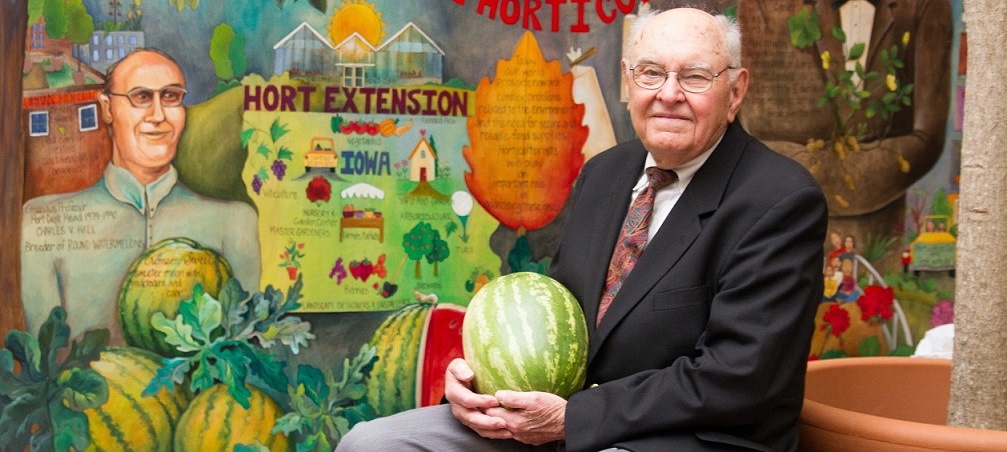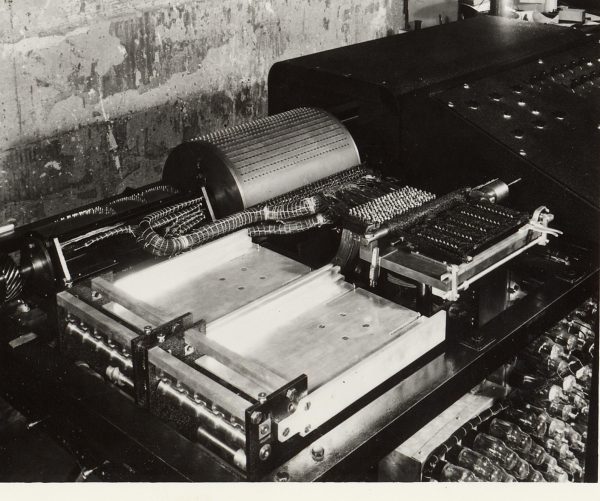
Charles Hall poses with a Crimson Sweet watermelon. (Provided by Iowa State University)
Innovation continues to grow at Iowa State University, and it has for decades. From advancing our daily technology to the foods we eat, ISU innovators have been at the center of it all.
Here are some of the most notable innovations from Iowa State over the years.
The electronic computer

The Atanasoff-Berry computer, the beginnings of the modern computer, was built at Iowa State from 1939 to 1942 by John V. Atanasoff, professor of physics and mathematics, and Clifford Berry, engineering graduate student, in the basement of Physics Hall.
Known as the “ABC,” the computer was created to solve simultaneous linear equations — it could handle up to 29 equations in a single problem — something that previously had never been digitized at this scale.
Using vacuum tubes to make faster calculations and capacitors to more efficiently store data, the computer was able to complete linear equations, completing about 30 addition or subtraction operations per second, according to the Computer History Museum.
The ABC was later dismantled in the late 1940s in part to salvage for parts and also because it could not fit through a doorway; it was the size of a large desk and weighed more than 700 pounds.
A smaller scale replica of the computer was built in the 1990s and is on display at the Computer History Museum in Mountain View, California.
Modern blue cheese
It may be stinky, but the blue cheese you smell while walking through the dairy aisle at the grocery store was developed at Iowa State in 1937.
Raw milk was used in the production of blue cheese before ISU Professor Bernard Wernick Hammer and graduate student C. B. Lane developed the Lane-Hammer process for making blue cheese with homogenized milk, according to the Iowa State Creamery.
Homogenized milk makes the cheese creamier by distributing the milk’s fat more.
Modern blue cheese, like the ones you find in the store, are made using this process.
Lead-free solder
In 1993, an alternative to lead solder was introduced and patented by Iver Anderson, who worked at Iowa State as a materials science and engineering adjunct professor and metallurgist at the Ames National Laboratory.
Solder is used to join tiny electronic components within a device so that an electric current can flow, allowing the device’s electronic functions to take place. Lead-based materials were widely used for soldering in electronics applications because of its low cost, strength and resistance to corrosion. As the poisonous effects of lead on humans and the environment became better known, it became imperative to find an alternative.
Using a mix of copper, tin and silver, Anderson created what would become the solder used in over 70% of electronic items in the world, according to a 2024 news release from the university.
The lead-free solder was the “all-time top-earning patent for Iowa State University and Ames National Laboratory,” with royalties coming to a near $60 million total before the patent expired in 2013, according to the release.
Anderson was inducted into the National Inventors Hall of Fame in 2017 and retired from the university in 2024 after 37 years in Ames.
The Crimson Sweet watermelon
The juiciest and sweetest watermelons — the ones we all crave on a hot summer’s day — come from the labors of Charles Hall, horticulture department chair from 1974 to 1990, from researching disease-resistant and flavorful melons.
Now, the Crimson Sweet melon is grown in more than 50 countries, according to a 2016 university news release.
Plenty of other fruits can be traced back to research at Iowa State, such as the Chieftain apple and Cyclone strawberries, but make sure you pick up a Crimson Sweet this summer.
Buck roses: The world’s hardiest
While not a single rose species, Buck roses — which are more than 85 varieties of hardy roses that thrive in harsher climates — were developed by Griffith Buck while at the university from 1949 to 1985.
These roses “are considered among the world’s hardiest and most beautiful,” according to a placard outside of Horticulture Hall. “Many of Buck’s roses seem to thrive anywhere, from the chilly Midwest to the sweltering South.”
Buck gifted his cultivars to friends, family and colleagues. As a result, Reiman Gardens is home to the largest collection of Buck roses — 86 to be exact, along with 15 geraniums and a heliotrope — with hopes to add more to its collection.
Honorable mention: Rice Krispies Treat
While not invented at the university, an Iowa State student developed the recipe for Rice Krispies Treats while working for Kellogg.
Mildred Day, who graduated in 1928 with a degree in home economics, worked at Kellogg developing recipes. In 1939, Day, along with co-worker Malitta Jense, created the treat with inspiration drawn from popcorn balls, according to the Iowa State University Biographical Dictionary.
The recipe was put to the test as a fundraising effort for Campfire Girls in Kansas City, and the treats were a hit. In 1941, the recipe was printed on the Rice Krispies box — and the rest is history.